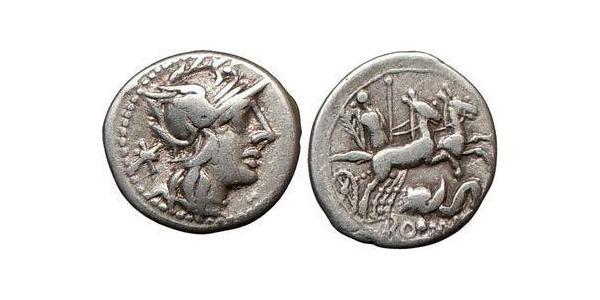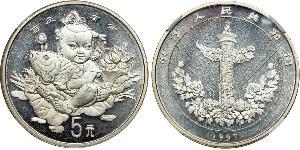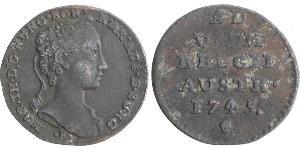[ 1878] L. Caecilius Metellus Diadematus moneyer Silver Denarius (19mm, 3.85 gm), Rome, 128 B.C. Rare. Reference: Caecilia 38; B.M.C. 1044; Syd. 496; Craw. 262/1 Head of Roma right, * behind. Pax in biga right, elephant's head below horses, ROMA in exergue. Provided with certificate of authenticity. CERTIFIED AUTHENTIC by Sergey Nechayev, PhD - Numismatic Expert In traditional Roman religion, Roma was a female deity who personifed the city of Rome and more broadly, the Roman state. Her image appears on the base of the column of Antoninus Pius. Roma, formerly queen of almost the whole earth. Horace (L. iv. od. 3) calls her the prince of cities; and according to Martial (L. xii. epig. 8) she is terrarum dea gentiumque. In Roman mythology, Pax (Latin for peace) (her Greek equivalent was Eirene) was recognized as a goddess during the rule of Augustus. On the Campus Martius, she had a temple called the Ara Pacis, and another temple on the Forum Pacis. She was depicted in art with olive branches, a cornucopia and a scepter. There was a festival in her honor on January 3. Daughter of Jupiter and Iustitia. Pax was often associated with spring. The Roman Republic was the phase of the ancient Roman civilization characterized by a republican form of government. It began with the overthrow of the Roman monarchy, c. 509 BC, and lasted over 450 years until its subversion, through a series of civil wars, into the Principate form of government and the Imperial period. The Roman Republic was governed by a complex constitution, which centered on the principles of a separation of powers and checks and balances. The evolution of the constitution was heavily influenced by the struggle between the aristocracy (the patricians), and other talented Romans who were not from famous families, the plebeians. Early in its history, the republic was controlled by an aristocracy of individuals who could trace their ancestry back to the early history of the kingdom. Over time, the laws that allowed these individuals to dominate the government were repealed, and the result was the emergence of a new aristocracy which depended on the structure of society, rather than the law, to maintain its dominance. During the first two centuries, the Republic saw its territory expand from central Italy to the entire Mediterranean world. In the next century, Rome grew to dominate North Africa, the Iberian Peninsula, Greece, and what is now southern France. During the last two centuries of the Roman Republic, it grew to dominate the rest of modern France, as well as much of the east. At this point, the republican political machinery was replaced with imperialism. The precise event which signaled the end of the Roman Republic and the transition into the Roman Empire is a matter of interpretation. Towards the end of the period a selection of Roman leaders came to so dominate the political arena that they exceeded the limitations of the Republic as a matter of course. Historians have variously proposed the appointment of Julius Caesar as perpetual dictator in 44 BC, the defeat of Mark Antony at the Battle of Actium in 31 BC, and the Roman Senate's grant of extraordinary powers to Octavian (Augustus) under the first settlement in 27 BC, as candidates for the defining pivotal event ending the Republic. Many of Rome's legal and legislative structures can still be observed throughout Europe and the rest of the world by modern nation state and international organisations. The Romans' Latin language has influenced grammar and vocabulary across parts of Europe and the world. Payment & Shipping: Will accept payments via PayPal. = MM_contentVersion;
}
else if (navigator.userAgent && navigator.userAgent.indexOf("MSIE")>=0 && (navigator.appVersion.indexOf("Win") != -1)) {
document.write('\n');
document.write('on error resume next\n');
document.write('MM_FlashCanPlay = ( IsObject(CreateObject("ShockwaveFlash.ShockwaveFlash." & MM_contentVersion)))\n\n');
}
if (MM_Fla ...
altro
Similar Coin Groups

10 Zloty Seconda Repubblica Polacca (191 ...
il gruppo ha 46 monete / 42 prezzi
Add coin to this group
2025-05-25
- New coin is added to 5 Yuan Cina Argento
5 Yuan Cina Argento
il gruppo ha 2 monete
⇑
China. 5 Yuan, 1997. KM-1058. Ornamental column. Reverse; Child holding carp. NGC graded MS-67: and 3 Yuan, 1997. KM-1075. Panda seated. NGC graded Proof 68 Ultra Cameo. Lot of 2 coins. Estimate ...
2025-05-25
- New coin is added to 1 Liard Paesi Bassi austriaci (1713-1795) Rame
1 Liard Paesi Bassi austriaci (1713-1795) Rame
il gruppo ha 4 monete / 4 prezzi
⇑
Austrian Netherlands. Maria-Theresa (1740-1780). Ae Liard, 1745 Angel head Brussels (Ae - 3,34g - 22mm). KM 1. About very fine.
Potresti essere interessato in…
















-300-150-P8gsHgTy6VEAAAGTRmDWdZPt.jpg)






